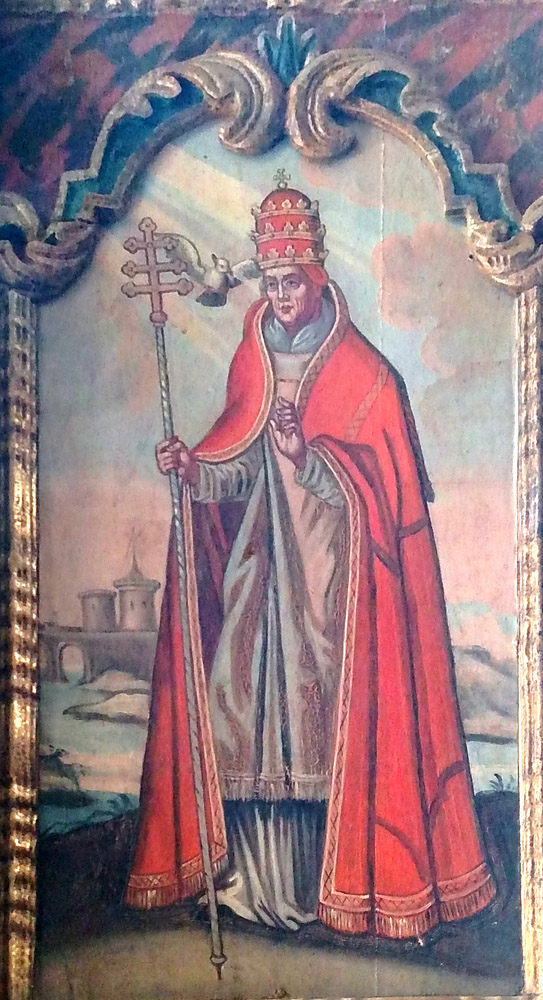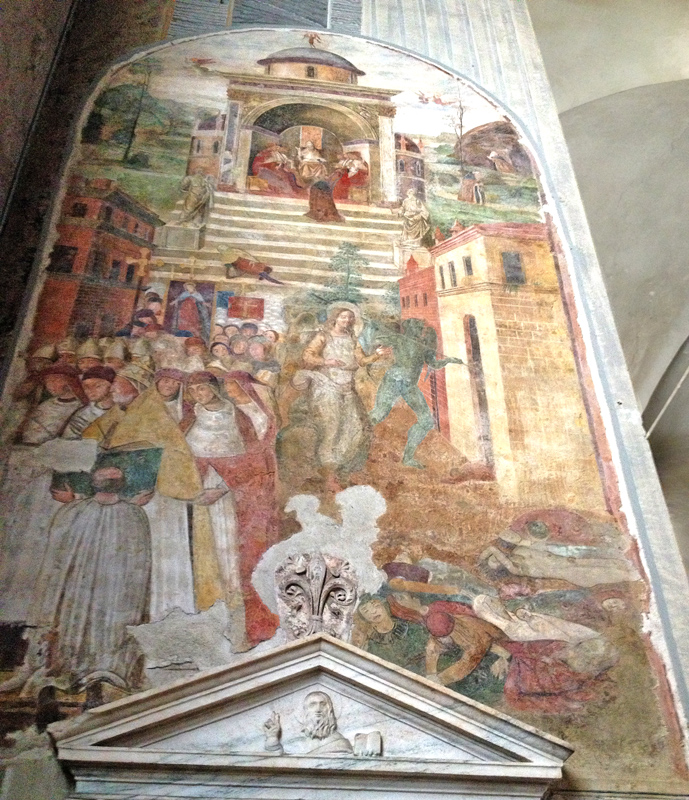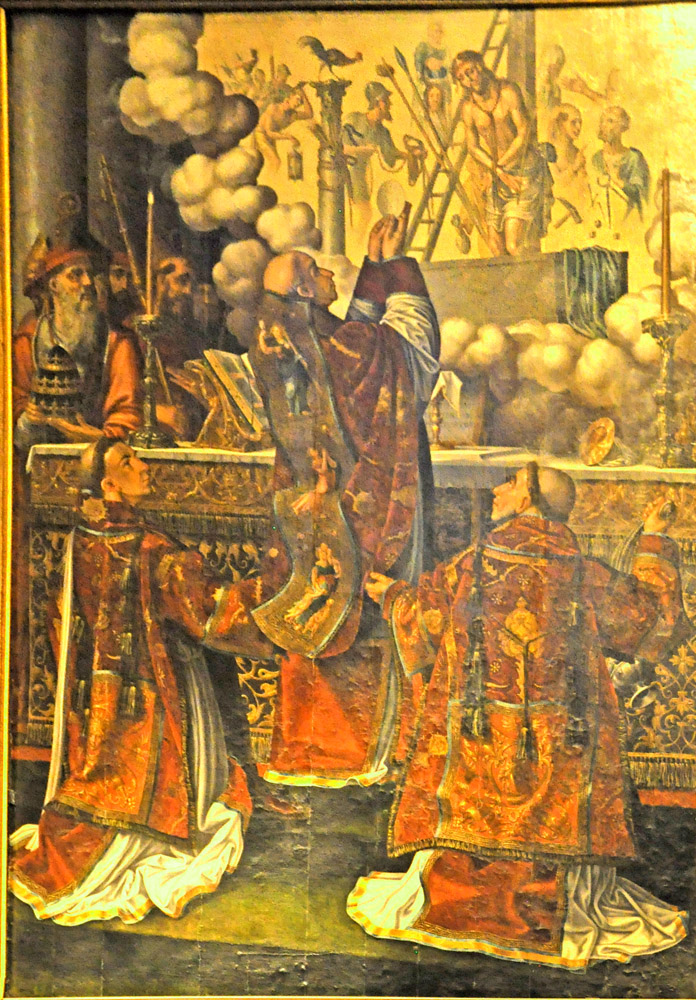ATTRIBUTES
One story omitted from the Golden Legend but found in other accounts had an important influence on the portraits. Gregory's amanuensis, St. Peter the Deacon, reportedly saw a dove alight on the saint while he was composing his homily on the Ezechiel 1:25, "a voice came from above the firmament." Whenever the dove would start whispering in the saint's ear, he would commence dictating to Peter, and when the dove stopped the dictation also stopped. The homily itself identified the voice in Ezechiel with the Holy Spirit that descended on Jesus at his baptism. On the strength of this story, the dove became a common attribute of St. Gregory, as in the first picture at right, though usually it is the saint himself who is doing the writing (example).3Other attributes relate to the office of Pope: the triple tiara and a papal cross (as in the first picture at right) or a scepter (example), and/or the pallium (example).
CHOSEN POPE AMID A GREAT PLAGUE
According to the Golden Legend the people of Rome chose Gregory to be their Pope when his predecessor was among the first to die in an epidemic of the bubonic plague. At the time he was a monk in one of the city's monasteries and had had plans to go to Britain to evangelize. To avoid the people he left the city surreptitiously and hid in a ditch, but they found him, aided by a pillar of light from Heaven (image), and had him consecrated Pope.As Pope, Gregory's first act was to organize three days of prayers and processions in which images of the Virgin and the crucified Christ were carried through the streets. The second picture on the right shows one of the processions.4 Gregory knew the plague was ending when he saw an angel descend to the summit of Hadrian's tomb and sheathe his sword. From then on, the tomb was known as Castel Sant'Angelo, "the castle of the holy angel." The Castel appears in the background of the first picture on the right. The third picture on the right illustrates the episode in the Golden Legend when St. Gregory was about to give a woman the communion host with the traditional words, "May the body of Christ protect you unto eternal life." When the woman smiled in seeming incredulity he took back the host, set it on the altar, and continued with the Mass. When the service concluded he asked the woman why she had smiled and she replied that she was the one who had baked that bread; how then could it be the body of Christ? Gregory used the occasion to caution the congregation about seeing only with the eye of the mind. Then he went back to the altar to get the host he had set aside. What he found, however, was a little finger bleeding on the cloth.
Subsequent retellings and images of this "Mass of St. Gregory" episode make the miracle more explicit and more dramatic. The finger becomes the entire body of Christ. The setting is a sumptuous cathedral. The woman is replaced by two attending deacons and a number of important-looking male bystanders. Often one of the bystanders is seen holding Gregory's tiara for him. In the background of many examples one sees the arma Christi, the instruments of Christ's passion (example).
"Eucharistic miracles" like this continued to be reported through the ages. One of the more famous was the "Miracle of Bolsena" in the 14th century. Another was reported at the Church of the Most Holy Trinity in Augusta, Georgia, in the 19th century.5 In Galicia an altarpiece memorializing another eucharistic miracle follows "Mass of St. Gregory" iconography precisely but sets it in parallel to a Pietà. Another episode in the Legend involves St. Gregory's prayer for the Emperor Trajan. As the Pope was passing through the Forum of Trajan, he was reminded of the man's many good deeds, particularly one in which he had set aside his preparations for war in order to hear a case brought by a poor widow. He had been reluctant at first, telling the woman she could wait till he returned (image). But she pointed out that if he died in the war some successor might hear her case. "What good will it do you if someone else rights my loss?" That convinced the emperor to do the right thing.
Weeping over the thought that pagan idolatry should keep this good man from Heaven, Gregory went to St. Peter's to pray for him. Then he heard God's voice promising that Trajan would be spared eternal punishment.
In the Divine Comedy Dante finds a carving of Trajan and the widow's story among the images of humility in Purgatorio X (70-93). Then he encounters Trajan himself in Heaven, just as God had promised Gregory, in Paradiso XX, 71-76.
In his Justice of Trajan (1840) Eugène Delacroix paints the scene of the widow and emperor as described in Dante and in the Legend. The painting applies Delacroix's well-known techniques of heroic portraiture to characterize the emperor in the moment before the woman's riposte changes him. The painter thus calls into question the very imagery for which he has become so famous.
THE MISSION TO THE ANGLO-SAXONS
According to the Golden Legend Gregory had been planning to go on mission to the Anglo-Saxons before he was persuaded to accept the papacy. He had encountered some young "Angles" being offered as slaves in the market and was struck by their fair hair and complexion. He said they were not "Angles" but "angels." A painting in the Church of St. Gregory in Ribeauvillé, France, appears to reference this story.
Prepared in 2014 by Richard Stracke, Emeritus Professor of English, Augusta University. Revised 2018-08-03, 2020-05-03.
HOME PAGE

St. Gregory the Great, with the Castel Sant'Angelo in the background. (See the description page.)

The Procession of St. Gregory, in Rome's Basilica of St. Peter in Chains. See the description page for details.

A Spanish Mass of St. Gregory. See the description page.
ATTRIBUTES
- Dove at his ear
- Papal identifiers: triple crown, pallium, papal cross or scepter topped by a cross
- Chalice
- Pen and book
MORE IMAGES
- Second half of the 14th century: Dalmasio di Iacopo Scannabecchi, Alms to a Shipwrecked Beggar and The Justice of Trajan in Santa Maria Novella.
- 15th century: In the predella of an altarpiece in Salamanca, a chalice is used as St. Gregory's attribute.
- Late 15th century: In his papal tiara but no other attributes, St. Gregory is included in this painting of the Four Doctors of the Church.
- End of the 15th century: A German triptych of the Mass of St. Gregory.
- 1497: A panel in a triptych follows the pattern for "Mass of St. Gregory" images. The priest shown may be St. Gregory himself.
- 16th century: Statue of St. Gregory as one of the Fathers of the Church.
- 16th century: Fresco in Croatia with dove, pen, and book.
- 1513-14: Molder's "Mass of St. Gregory" – background is not the arma christi but just the Cross and the pillar where Jesus was scourged.
- 1573-75: Zucchi's Procession of St. Gregory.
- 1594: A detail from Tintoretto's Coronation of the Virgin with Gregory and other Benedictines.
- Second half of the 18th century: A statue of St. Gregory with dove, pen, book, and tiara.
- Undated: The dove whispers in St. Gregory's ear in this fresco in South Tyrol, Italy.
IMAGES IN PUBLICATIONS
- Late 13th century: Plaque with St. Gregory, dove approaching his ear. Prelatical mitre, crozier, and pallium. Wood and gilded silver repoussé. In St. Mary's Convent, Zadar. In Petricioli, 22.
DATES
- Born circa 540, died 604
- Feast day (Roman Catholic): September 3, for the day he was consecrated Pope in 590.
- Feast day (Other churches and secondarily for Roman Catholics): March 12, for the day he died.
NAMES
- In Orthodox hagiography called "Gregory the Dialogist"
BIOGRAPHY
- Golden Legend #46: html or pdf
- The South English Legendary (in Middle English), 355-59
- Roman Breviary: English translation, I, 805-806; Latin original, 835-37
- John the Deacon's Life of Gregory (in Latin): Acta Sanctorum, March vol. 2, March 12, 135-208)
- Anonymous Latin Life: ibid., 130-135
- Liber beati et laudabili viri Gregorii, ed. Gasquet
NOTES
1 Butler, I, 566-71, Catholic Encyclopedia s.v. "Pope St. Gregory I," Bede, Ecclesiastical History, II, 1.
2 Acta Sanctorum, March vol. 2, 132. Roman Breviary, I, 806.
3 Gasquet, 34. Acta Sanctorum, ibid., 135.
4 In this painting the Virgin's banner is a copy of Our Lady of Mercy. In Giovanni di Paolo's version in the Louvre, the banner bears a copy of the perhaps more appropriate Salus Populi Romani, a Madonna whose title that can mean either "the health of" or "the salvation of" the Roman people. Di Paolo's painting is published on this page at Wikimedia Commons (retrieved 2021-12-05) and on p. 151 of One Hundred Saints.
5 Mitchell, 10.